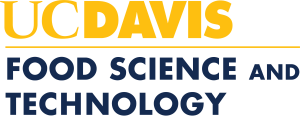COURSE GOALS: The goal is to give a basic background in food experimental design and data analysis as part of the general skills of food scientists, which will have an impact on all Food Science courses with laboratory components, and to provide the specialized requisite design and analysis skills needed for the laboratory classes associated with FST 107A (Food Sensory Science, for which the course is a pre- or co-requisite). FST 107A will compliment this course by giving laboratory applications for the principles learned in this class. This course will also give a grounding in design and analysis for the laboratory sections of FST 107B, FST 127, and FST 207.
TEXT USED: There will be two texts:
- Sensory Evaluation of Food (publ., Marcel Dekker) by Michael O'Mahony.
- A compendium of course notes and applied food examples to be available at the UCD Bookstore.
ENTRY LEVEL: STA 13: fall
GRADING AND COURSE REQUIREMENTS: The course is an applied course and thus grading will depend on the students' skills at application of their knowledge to food science problems. Students will be required to perform practical lab. exercises each week. A letter grade will be based on performance of these eight exercises, random 'surprise' quizzes, and a final test. The exercises will contribute 70% to the grade, the quizzes 15%, and the final 15%.
TOPICAL OUTLINE: For all design and analysis topics, students will be given examples of appropriate experimental designs using trained panelists and untrained consumers. The relative merits of various design strategies will be discussed. Issues of practice, fatigue, judgment bias, and the issues associated with related (paired) vs. independent samples designs, especially with intensity and hedonic measures, will be discussed. Issues of statistical data analysis will also be discussed. Attention be given to null and alternative hypotheses for each topic and the interpretation of the sensory data analysis in the light of these hypotheses. Examples of misinterpretation from case studies in the industry will be discussed. Computation will involve SAS and Excel programs to match the packages commonly used in the food industry. Yet initially, statistical calculations will be performed by hand to give students a thorough understanding of the structure of the computations, which will allow a clearer understanding of the conclusions to be drawn from data analysis as well as easier troubleshooting when calculations are performed by computer.
The following topics will be addressed:
- Examination of data from food flavor intensity estimations and hedonic estimates
- Summary descriptive statistics. Central tendencies and dispersions. Normal distributions.
- Probability calculations.
- The logic of statistical testing as illustrated by the binomial test.
- Traditional application of binomial statistics to discrimination testing.
- Chi-squared designs.
- t-tests.
- One-, two-, three-, four-factor ANOVA as applied to sensory data.
- Issues of when judges and replicate food samples are treated as treatments or replicates.
- Interpretation of interaction effects in sensory data.
- Computations for fixed effects, random effects, and mixed models.
- Storage studies.
- Unusual approaches for quality assurance.
- Correlation (Pearson's r and Spearman's rho) and least squares linear regression as applied to sensory data.
- Ranking tests.
COURSE FORMAT: One 3-hour lecture per week and one 1-hour discussion period.
POTENTIAL COURSE OVERLAP: There will be some deliberate yet controlled overlap with FST 107A for which this course will be a pre-requisite. FST 107A will provide 'hands on' practical examples from food sensory science lab. classes in which to apply the skills acquired in this course.
